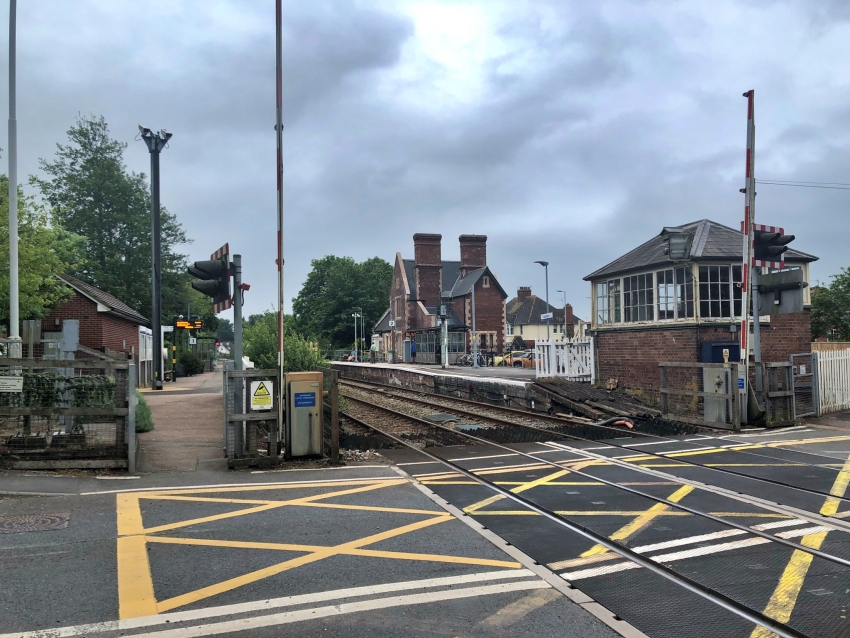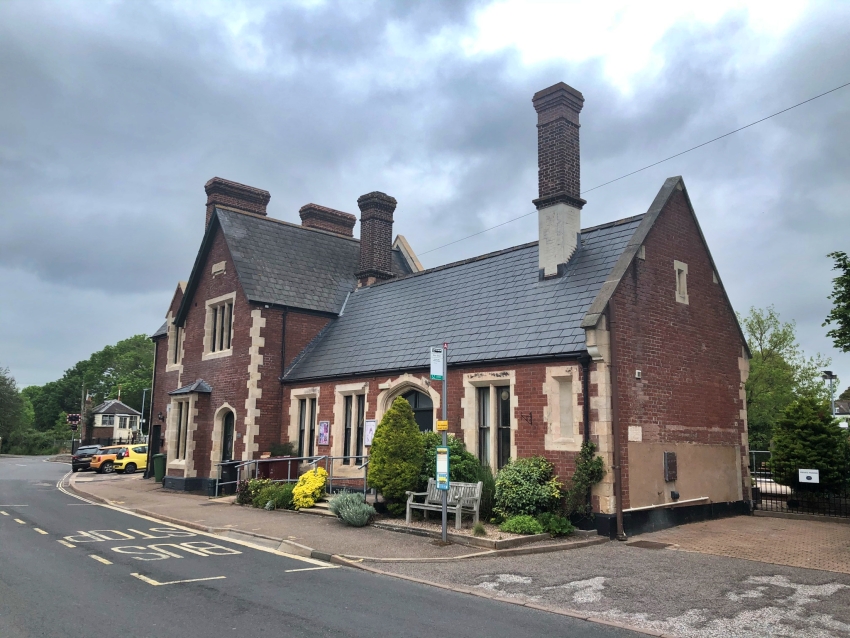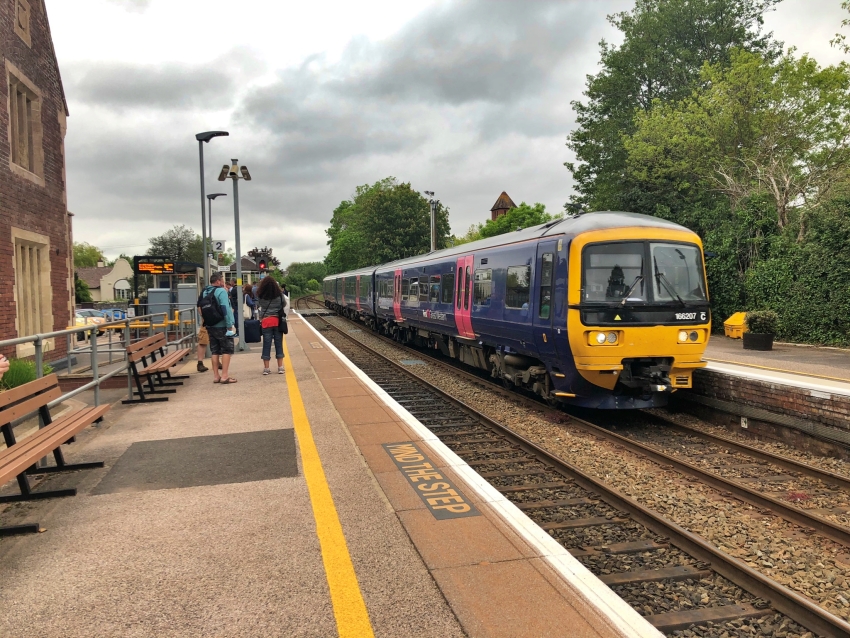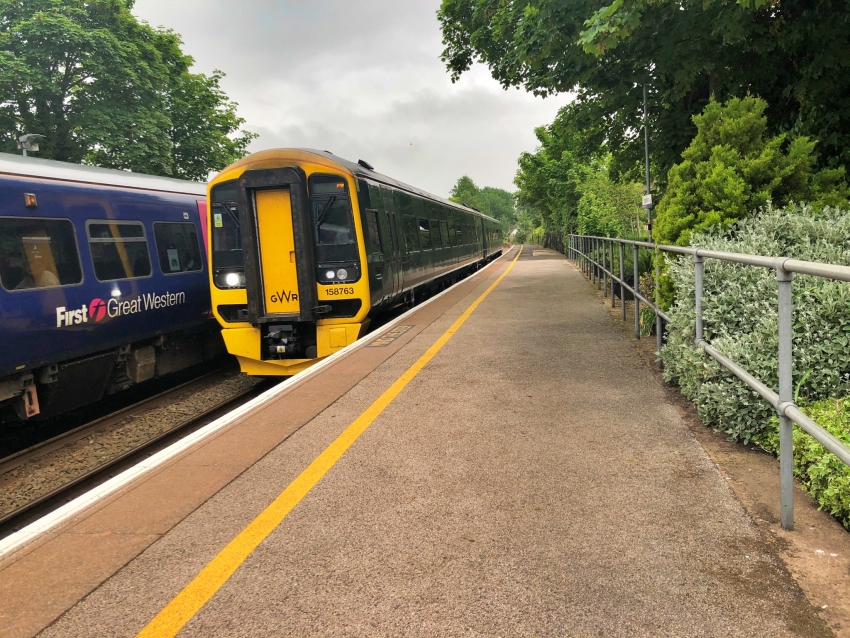Topsham
In the year of the Exmouth branch’s opening, 1861, Topsham’s population was recorded at 3,503, and traffic on the line from the outset was considered to be satisfactory. A timetable from winter 1874 shows seven "up" trains and an equal number in the "down" direction from Monday to Saturday inclusive; the service reduced to four trains in either direction on Sundays.
Based on a letter written to a local newspaper, no protection from the elements was provided for passengers waiting on the "down" platform from the outset:
Topsham Railway Station
To the Editor of the Exeter & Plymouth Gazette.
Sir - I hear from good authority that the Topsham railway platforms are to be asphalted very shortly. Therefore, I trust you will allow me space in your valuable paper to suggest a place of shelter be erected on the down platform, also another seat; for I witnessed on Monday evening last, when the rain was coming down in torrents, passengers waiting in the signal-box, the said box being about 4-ft. by 6-ft. You may imagine how many can take shelter there, considering also that the signalman has his duties to perform. [The Exeter and Plymouth Gazette, Friday, 29th September 1882]
The above indicates that the signal box, which was not an original feature of the station, was in use by 1882; it was situated at the Exeter end of the "up" platform, adjacent to the level crossing. The cabin was an in-house design of the LSWR, with hipped slated roof, but unlike those on the main line, was of all-brick construction, rather than at least comprising a timber upper half. As for "down" side cover, an Ordnance Survey map from 1889 shows that a passenger waiting shelter was by that time available for Exmouth-bound passengers.
In 1907, work started on doubling the line between Exmouth Junction and Topsham. This formed part of a scheme by the LSWR to retain local traffic in Exeter’s suburbs, given the competition the company faced from the city’s encroaching tram network. The project involved commissioning a pair of timber-built halts as part of a "railmotor" service, linking the city’s suburbs with Queen Street station and Topsham, with onward travel from the latter to Exmouth. In brief, the LSWR’s "railmotor" was a single steam-powered carriage, which was seen as a cost-effective solution to handle short distance stop-start traffic patterns. The double-track and railmotor service came into use on 1st June 1908:
By Motor to Topsham
The L. and S. W. Rail motor-car service between Queen-street, Exeter and Topsham was started under very favourable conditions yesterday, and the number of passengers who have so far patronised the motors is considered by the Company in every way satisfactory. The ordinary Exmouth traffic on Sunday was run over the new double line as far as Topsham in order to make sure things were in thorough working order.
The Company intend the primary purpose of the service to be the linking up of four Halts. Lion’s Holt, Mount Pleasant, Polsloe Bridge, and Clyst St Mary, with Exmouth, the time-table being so arranged that passengers journeying by rail to Topsham have only a short time to wait there for the Exmouth trains. [The Western Times, Tuesday 2nd June 1908]
In 1924, the council lobbied the Southern Railway for a footbridge to be provided at Topsham, in light of an accident in that year which saw a person knocked down by a train at the level crossing. However, after a vote, it was decided not to move forward with such provision:
As a result of the fatal accident when Mr. F. Pyle was knocked down by a train at the level crossing near Topsham railway station last July, the Topsham Parish Council the following month wrote to the Southern Railway Company asking that a footbridge be provided at the point. The Company replied that so far back as 1895 representations were made by the Parish Council as to the necessity of a footbridge, and a plan was prepared. A few months later a further communication was received from the Council, enclosing a petition from residents objecting to the proposed bridge, the scheme consequently being abandoned. At present, the cost of a footbridge would be somewhat high, and the company would like to know whether the resolution passed by the Council might be taken as representing the general feeling of the inhabitants, and if so whether the Council would be prepared to contribute towards the cost.
A vote of seven expressed themselves in favour of the scheme and 30 against.
.... it was decided that the Railway Company be asked to employ a disabled ex-Service man at the level crossing to warn people of approaching trains.
[The Devon and Exeter Gazette, Thursday 27th November 1924]
Changes under the Southern Railway at Topsham were largely superficial, including the installation of that company’s trademark swan neck gas lamps, "Target" name signs, in addition to platform name boards supported upon concrete posts. This company also extended both platforms at their Exmouth ends using prefabricated concrete, the components of which were manufactured at their nearby Exmouth Junction works.
By the mid-1950s, the main station building’s ornate red brickwork had been painted over with a whitewash finish; Tite’s structures on the main line, such as at Honiton and Seaton Junction, received the same treatment. Additionally, the main pitched roof of Topsham’s station building was extended beyond the forecourt-facing facade, so it now overhung (this is illustrated in the accompanying photographs). Then, in 1957, the single-track branch to Topsham Quay ceased to be used; indeed, a listing in The Estates Gazette publication on 19th January 1957 advertised a freehold space available at the site, which is perhaps indicative of the changes which led to the abandonment of the railway connection:
Possession spring 1957. Freehold; £10,000; Exeter 4 miles. Topsham Quay (Good road and water access; wharf about 200 ft. length; accommodates boats 350 tons): Modern Multi-Storeyed Building (Steel framed; brick walls).
Reportedly, the trackwork to the quay was lifted as soon as 1958.
1963 was a big year for the Exmouth branch. On 1st January, it was one of a series of lines which passed from Southern to Western Region control under British Railways’ organisational structure. Then, on 27th March, the much-anticipated Beeching Report was published, within which both branch line routes to Exmouth, via Topsham and Budleigh Salterton, were recommended for closure. In spite of Exmouth being a popular holiday resort, closure was justified on the basis of the town being well connected by road. However, after protests, the Exmouth branch via Topsham avoided closure:
Railway Closure: Exmouth Protest
Exmouth Council’s Publicity Committee yesterday welcomed the decision of the British Railways Authority not to close the Exeter to Exmouth branch line.
The committee, however, decided to lodge a formal objection to the proposed closure of the Exmouth to Tipton St. John branch line. [Friday Herald Express, 4th September 1964]
Now back to the specifics of Topsham. In Clinker’s Register, 1980, it is noted that the station ceased to be staffed on 28th February 1965, save for the signalman in the cabin by the level crossing. The goods yard closed to public goods traffic on 4th December 1967. From 5th February 1973, that part of the branch north of Topsham was degraded to single-track working, just a very brief stretch of double line existing immediately south of Exmouth Junction. On 20th May of the same year, the traditional level crossing gates were superseded by powered lifting barriers, controlled from the adjacent LSWR signal box.
As late as 1977, the station still retained the SR’s swan neck lampposts and green platform run-in boards; furthermore, the waiting shelter of the 1880s and "up" side canopy attached to the main building were still standing by this time. However, by January 1981, modern lampposts had been installed, the "up" side canopy and "down" shelter demolished, and glazed bus shelter-style structures installed on both platforms. Finally, on 31st January 1988, Topsham signal box closed, control being passed to the panel at Exmouth Junction; as part of this, semaphore signals at the station were replaced by colour aspect lights, and the short stretch of double-track adjacent to the main line was removed. Five years later the goods shed, which since closure had been referred to on maps as plain "depot", was demolished.
In 2005, the platform shelters of about 1980 origin were replaced with more futuristic-looking structures, built to a design which seems to have become a standard, at least in Southern England. So, today, these shelters are all that waiting passengers have to avoid the wind and the rain; however, for the historian, at least Tite’s original main building – albeit not in railway use – still stands, as does the former signal box. The station building was the subject of a restoration in 2020, which saw the white paint removed and the original red brickwork restored. This formed part of a scheme to convert the building into flats.
5th June 2021

By the time of this view, the signal box had lost its net curtains but, more significantly, Tite's main building had been rid of its whitewash finish and returned to the spendid original red brickwork. The tall post on the Exmouth-bound platform, on the left, supports CCTV cameras used to monitor the level crossing from Exmouth Junction. © David Glasspool
5th June 2021

The former main building was renovated in 2020, when the opportunity was taken to incorporate a series of new flats within it. Note that this facade lacks the original high-sided gable of the platform-facing elevation; instead, the slate tiles extend beyond the roof line. © David Glasspool
5th June 2021

Diesel electric multiple unit (DEMU) No. 166207 is seen arriving with a Paignton to Exmouth service. This class of DEMU was largely displaced from their territory on suburban lines serving Paddington, after electrification between the capital to just short of Bristol. © David Glasspool
5th June 2021

DEMU Class 158 No. 158763 is seen arriving with the 18:26 departure from Exmouth, bound for Paignton. It was running about nine minutes late due to serving a couple of the request stops between Exmouth and Topsham, and was packed inside like a tin of sardines. © David Glasspool
Return to the Kent Rail Homepage or alternatively, check for Updates.
Website & Copyright information - Links - Contact the Webmaster
